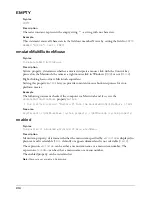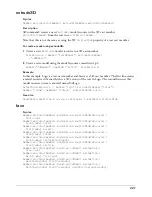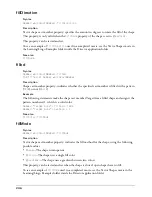
222
Place
on exitFrame
handlers in behavior, frame, or movie scripts, as follows:
•
To assign the handler to an individual sprite, put the handler in a behavior attached to the sprite.
•
To assign the handler to an individual frame, put the handler in the frame script.
•
To assign the handler to every frame unless explicitly instructed otherwise, put the handler in a
movie script. The
on exitFrame
handler then executes every time the playhead exits the frame
unless the frame script has its own
on exitFrame
handler. When the frame script has its own
on exitFrame
handler, the
on exitFrame
handler in the frame script overrides the one in the
movie script.
This event is passed the sprite script or frame script reference
me
if it is used in a behavior. The
order of frame events is
prepareFrame
,
enterFrame
, and
exitFrame
.
Examples
This handler turns off all puppet conditions when the playhead exits the frame:
on exitFrame me
repeat with i = 48 down to 1
sprite(i).puppet = FALSE
end repeat
end
This handler branches the playhead to a specified frame if the value in the global variable
vTotal
exceeds 1000 when the playhead exits the frame:
global vTotal
on exitFrame
if vTotal > 1000 then go to frame "Finished"
end
See also
on enterFrame
exitLock
Syntax
the exitLock
Description
Movie property; determines whether a user can quit to the Windows desktop or Macintosh
Finder from projectors (
FALSE
, default) or not (
TRUE
).
The user can quit to the desktop by pressing period (Windows) or period
(Macintosh), Q (Windows) or Q (Macintosh), or W (Windows)
or W (Macintosh); the Escape key is also supported in Windows.
This property can be tested and set.
Examples
This statement sets the
exitLock
property to
TRUE
:
set the exitLock to TRUE
Summary of Contents for DIRECTOR MX-LINGO DICTIONARY
Page 1: ...Lingo Dictionary Macromedia Director MX...
Page 756: ...Index 756...
















































